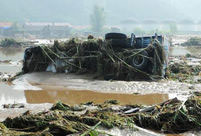 Death toll in Philippine ship collision climbs to 31
Death toll in Philippine ship collision climbs to 31
 Guangzhou rail service suspended, 80,000 affected
Guangzhou rail service suspended, 80,000 affected
 Beijing Int'l Light Festival kicks off
Beijing Int'l Light Festival kicks off
 Indian-controlled Kashmir celebrates Independence Day
Indian-controlled Kashmir celebrates Independence Day
 Reservoirs in S China start to release floods
Reservoirs in S China start to release floods
 Asian Youth Games opens in Nanjing
Asian Youth Games opens in Nanjing
 How do North Koreans stay cool in summer?
How do North Koreans stay cool in summer?
 China Beijing Int'l Gifts, Premium&Houseware Exhibition opens
China Beijing Int'l Gifts, Premium&Houseware Exhibition opens
 Incredible gardens around the world
Incredible gardens around the world
Monitoring carbon dioxide and humidity in the world heritage-listed Mogao Grottoes has been introduced to better protect the caves, experts with Dunhuang Academy said.
The grottoes, known for their Buddhist statues and frescoes, are near the oasis city of Dunhuang in southwest China's Gansu Province, a key stop-off point along the ancient Silk Road.
Thousands of visitors swarm every day to Mogao, the home to more than 2,000 colored sculptures and 45,000 square meters of frescoes in 735 caves carved along a cliff by ancient worshippers.
But it is not unusual that tourists are prevented from entering a certain cave as a sign in front of the locked door reads, "Temporarily closed due to carbon dioxide exceeding the standard."
A monitoring center was set up in June to monitor 24 pieces of different data in each cave including carbon dioxide concentration, humidity and visitor flow. The system issues a warning if any of the data exceeds the standard.
"We have used wireless sensor networks and other digital technologies to help analyze the correlation between environmental data in the caves and the extent of cultural relic erosion, to preserve the murals and sculptures in a more scientific way," said Wu Fatian, an academy researcher.
Experiments showed that glutenite, the supporting material for the murals, becomes active if humidity in a cave surpasses 62 percent. The murals might then become fragile and even fall off, said Fan Jinshi, the head of Dunhuang Academy.
"Of the 735 caves found in Mogao Grottoes, only 40 of them with an area of 50 to 100 square meters are opened to visitors. Most of the caves have an area smaller than 25 square meters. The vapor and carbon dioxide people exhale causes erosion and other damage to the murals and sculptures in such a limited area," said Fan.
More than 5,000 tourists have visited the grottoes each day since July. During the seven-day national day holiday in 2012, the daily number of tourists topped 18,000. However, academy experts said an acceptable number should only be about 3,000.
Carbon dioxide will not only damage historical relics but affect people's health.
"Once an interpreter passed out due to the high concentration of carbon dioxide in one of the caves," Fan said.
To ensure visitor safety and protect the cultural relics, the visiting route will be altered according to data collected.
Besides, digitizing the murals has been the trend for the preservation in many museums across the world.
"No matter how advanced the technology can be and how careful our experts are, these caves and murals will fade away in the future. To help preserve the original face of them, digitization is now the best choice we have," Fan told the Guangming Daily .
According to the introduction by Sun Zhijun, vice director of digital center at Dunhuang Academy, the whole process includes two parts, breaking them into pieces and assembling pieces into a whole. Every mural is photographed into various small parts, which will be assembled into the original one using specialized software.
"It is a tough, boring and complicated process. Each of our team members has to stay in the dark and stuffy cave for seven or eight hours each day. A photographing team, made of four members, uses high resolution cameras to record all the info on each mural," Sun said.
Even digitization of a single cave will take several months. Take the No.61 cave for example. The photography work took four teams about two and a half months. But the processing time is even longer, even triple or quadruple the photographing time.
Until now, a total of 59 caves have been photographed and the processing work for 22 of them has been done. The area of photographed murals is about 10,812 square meters, about 24 percent of the total number of Dunhuang Grottoes' murals, said Sun.
"With these high definition digital images, the visitors will be able to appreciate all the murals in a clearer and better way. They can look at them as long as they like," Fan said. "That way, the cave visitors will reduce. So we can have the strictest preservation on those culture treasures."
A traveler center, not far away from Dunhuang Grottoes, will be put into use in May, 2014. "There, travelers will have a different view and experience from real cave view. A ball-shape screen will display the splendid and beautiful view of the caves to travelers," said Fan.
 Premier Li: We rely on farmers for a living
Premier Li: We rely on farmers for a living Floods force evacuation of 80,800 people in NE China
Floods force evacuation of 80,800 people in NE China Top 10 pricey destinations for studying abroad
Top 10 pricey destinations for studying abroad 173 killed, 1,330 others injured in clashes across Egypt
173 killed, 1,330 others injured in clashes across Egypt Beijing Int'l Gifts, Premium & Houseware Exhibition opens
Beijing Int'l Gifts, Premium & Houseware Exhibition opens Bolt claims 200m title at IAAF World Athletics Championships
Bolt claims 200m title at IAAF World Athletics Championships Escort taskforce holds anti-hijacking drill
Escort taskforce holds anti-hijacking drill Egypt's clashes kill 525 so far
Egypt's clashes kill 525 so far Sex offenders prey on left-behind kids
Sex offenders prey on left-behind kids Jaguar Land Rover to recall 11,852 cars
Jaguar Land Rover to recall 11,852 cars Ballet Swan Lake rehearsed in Taipei
Ballet Swan Lake rehearsed in Taipei  The five Hutong areas of Beijing
The five Hutong areas of BeijingDay|Week|Month